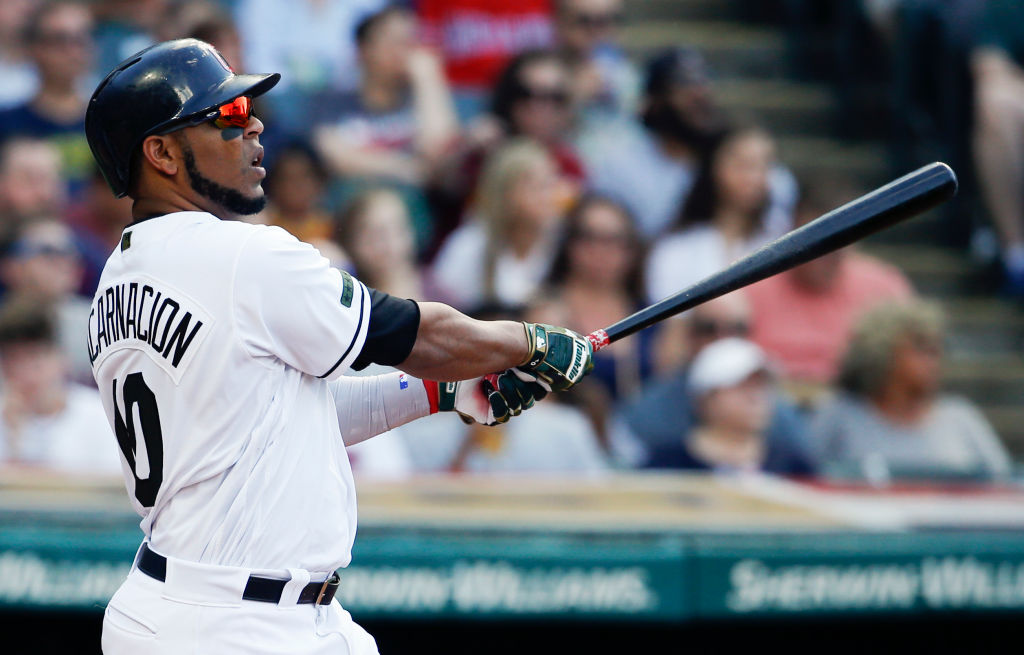When the Cleveland Indians signed Edwin Encarnacion to a 3 year/$60 million contract in January, they were paying for one of the game’s best hitters, albeit in his post-prime years. Since 2012, Encarnacion is one of only six players with 150+ home runs and a .360+ on-base percentage, joining Jose Bautista, David Ortiz, Giancarlo Stanton, Miguel Cabrera, and Mike Trout. Despite 2016 being one of Encarnacion’s worse years – his 134 wRC+ was his worst mark since 2011, and his 19.7% strikeout rate was his highest since 2009 – Encarnacion was still a force at the plate. Naturally, Cleveland fans everywhere were thrilled with the signing of the true right-handed power bat that had eluded the club for years.
However, through his first 36 games of 2017, it appeared decline had hit Encarnacion much faster than anticipated. The Dominican-born slugger was only slashing .206/.353/.341, and his 28% strikeout rate was a concern. Encarnacion was still the patient hitter he’d always been, demonstrated by his impressive 16.6% walk rate in the stretch, but the contact ability and power he was famous for had vanished.
No one was panicking yet, but many Cleveland fans were concerned the Indians made a mistake handing $60 million to an aging player. Some writers were quick to point out that Encarnacion is a notorious slow-starter: For his career in April and May, Encarnacion’s wRC+ is 102 and 119, respectively, down from his career 125 mark. Still, Encarnacion’s 28% strikeout rate seemed to point to a bigger problem. Though his production in the early months of the season is usually below his standard, his strikeout rates never ventured north of 20%.
As concern began to build, Encarnacion started to deliver some relief. In his past 59 plate appearances over 14 games, the 34-year-old has put up a .291/.339/.600 slash line, paired with a much more palatable 20.3% strikeout rate. While this sample is still small, it does represent the type of production expected of Encarnacion, and supports the notion that the slugger is indeed a slow starter who needed a chance to warm up.
So, what led to Encarnacion’s turnaround? Although his 16.6% walk rate through 36 games would indicate a strong ability to avoid chasing pitches, Encarnacion was swinging at the wrong pitches inside the strike zone early this season. Consider this gif, showing a heat map of the percent of pitches Encarnacion swung at by location. The first image shows the first 36 games of 2017, while the second shows his next 14:
In April and through mid-May, the heat maps tell us that Encarnacion was swinging most often at pitches in the upper-part of the strike-zone. More recently, he’s shifted his focus to swinging at strikes in the middle and lower-parts of the zone. This change was a very important one for Encarnacion, as historically, he’s produced better against pitches lower in the strike zone. We can see this in the heat maps below. The first heat map represents contact percentage by pitch location, while the second shows isolated power by pitch location – both for Encarnacion’s career.
As we can see, Encarnacion’s career contact percentage against high pitches has sat between 78-90%, and it sits at a stronger range of 86-96% in the lower part of the strike zone. Along with making more contact on lower pitches, Encarnacion also hits for more power in the lower half, where his ISO by pitch sits between .042-.128, while it is a lower .024-.118 in the top of the zone.
Now, Encarnacion’s recent production hasn’t been perfect – his .600 slugging percentage in the recent stretch isn’t sustainable, his 6.8% walk rate is lower than it should be, and you’d like to see his strikeout rate dip below 20% to align with his track record. Moreover, his numbers with runners in scoring position have been abysmal, batting .122/.267/.245, but we know hitting well in those situations isn’t a repeatable skill. Regardless of the work that still needs to be done for Encarnacion, it’s clear that he’s been doing himself a favor by holding off on high pitches, and instead opting for lower pitches that he typically hits harder and more frequently.
But can better plate discipline solve everything? Even though Encarnacion has seen better results recently, some fans have seemed concerned about his bat speed:
https://twitter.com/Pynchump216/status/868599947867848704
While this is a legitimate concern – aging players typically see a decline in bat speed – Tribe fans will be relieved that this doesn’t seem to be the case, based on Statcast’s estimated swing speed metric. Of players with at least 50 results, Encarnacion’s average swing speed has ranked the best on the team, at 61.4 mph.
So, despite the title of this article, Edwin Encarnacion never really went anywhere. The many writers who pointed towards his usual early-season struggles were largely correct, and at least a portion of his contact and power issues early in the season derived from poor pitch selection that has since been corrected. To boot, it seems like Encarnacion’s bat speed is just fine, despite being 34.
The conversation about Encarnacion’s contract being too much for an aging player well come, but as of this writing, we haven’t gotten to that point. Until then, fans can keep enjoying monster home runs from Encarnacion, like this one off Daniel Mengden last week.
[mlbvideo id=”1441666983″ width=”400″ height=”224″ /]Add The Sports Daily to your Google News Feed!




